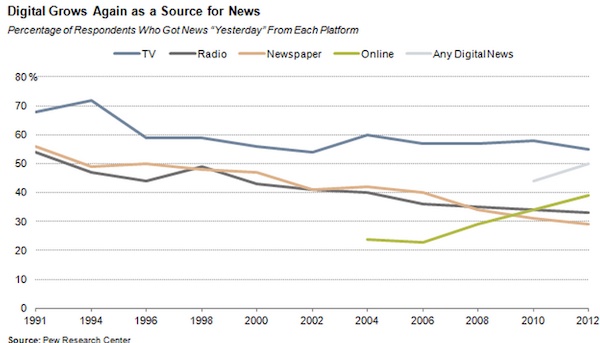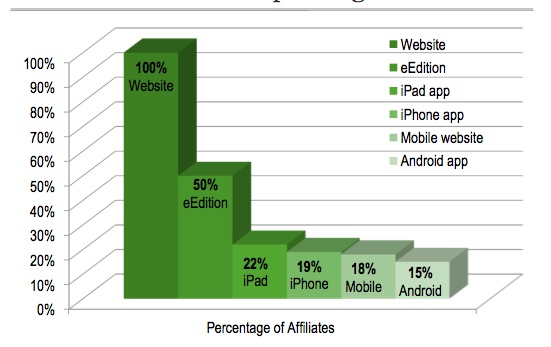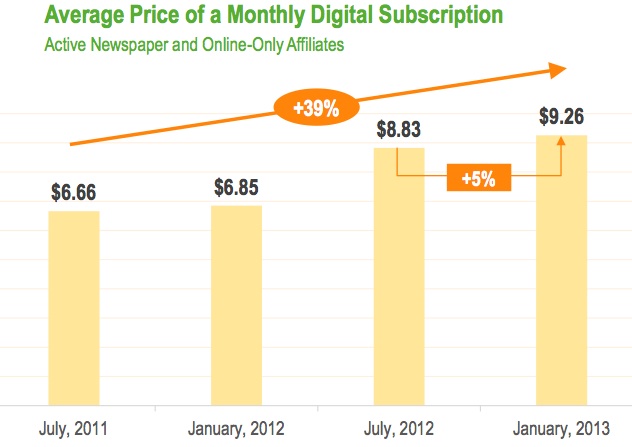One of the truisms of digital journalism, and one that happens to be true, is that mobile is a big part of the future of news, if it isn’t the future.
The latest Pew “State of the Media” report goes on at length about the migration of news to mobile in a section titled, aptly, “Digital: As Mobile Grows Rapidly, the Pressures on News Intensify.”
Here are the numbers, according to Pew:
Thirty-one percent of adults now own a tablet, roughly triple May 2011 levels; 45 percent of adults own a smartphone, up 10 percentage points from May 2011; Apple sold 65.7 million iPads worldwide last year, around 62 percent of the tablet market, with plenty of competitors accounting for the rest.
Pew says that’s a good thing for news:
That growth appears to be a boon for news since accessing news is one of the most popular uses for the devices, enabling Americans to get news whenever they want and wherever they might be.
Fully 64% of tablet owners say they get news on their devices weekly and 37% report they do so daily, according to a survey conducted by the Pew Research Center and the Economist Group. The trend is nearly identical for smartphone owners – 62% get news on their device weekly and 36% do so daily.
And here’s a graphic showing digital’s climb as a source: mobile falls under “any digital.”

So far, so good.
Indeed, Pew quotes Raju Narisetti, then the head of The Wall Street Journal‘s Digital Network, at a February 2012 presentation at the Digital Media Strategies conference in London: “Last month, 32 percent of my traffic came from mobile. A year ago it was 20 percent and a year from now it will be 50 percent.”
So readers are ready for mobile news. Fine. But are newspaper companies ready to deliver it? For the large majority of them, the answer is no.
Here’s some recent research from Press Plus, the digital-subscription services company founded by Steven Brill and Gordon Crovitz that has more than 420 customers, 380 of them newspaper companies, about a third of the 1,300 or so newspaper companies. Brill says the company has more than 95 percent of the market of companies with metered subscription models. Most of the customers are local papers or chains of local papers. Some of the bigger papers—The New York Times,, The Wall Street Journal, the Financial Times—have their own systems. But the Press Plus client list—which includes the McClatchy and Tribune chains—is a reasonable sample of the newspaper business.

So we learn that only 22 percent of Press Plus clients, the vast majority of which are newspaper companies, are even able to offer their content on tablets, which are owned, we learned above, by about a third of their customers. Even fewer can deliver to a smart phone, a technology now owned by half the country.
And what’s that large bar called “eEdition,” which half the clients are able to provide? That’s the digital edition, often PDFs, formatted to look like the printed version that newspapers rolled out in the early days of the media transformation—in other words, legacy technology.
The headline on the graph, by the way, which I chopped off to avoid confusion, says: “And Publishers are Responding to the Demand.” Actually, not very quickly.
In an email, Brill notes that newspapers are moving in the right direction: “A year ago that number was probably 1 to 2 percent. Next year 50-75 percent.”
Well, one hopes.
He also says publishers’s slowness in setting up mobile capability is a function of the fact that they’ve only recently begun to charge for content. And since browsers are by far their biggest market, that’s where they started. “That they are just now moving on from there to address the smaller but soon-to-be large mobile audience is hardly surprising and hardly something to be critical about.”
Sure. But the issue is adapting to reader tastes, whatever the model, free or subscription. Both need as many readers are possible. And browsers will naturally dominate until mobile capacity is developed.
Look, there’s been some reasonably good news for newspaper companies lately, at least on the circulation side. They are indeed turning to paywalls in ever-greater numbers, and we think that’s a good thing, and that the arguments against them are mostly faith-based.
Digital subscription rates are rising, as Press Plus has documented among its clients:

But that doesn’t help much if companies can’t offer their product on devices that readers are turning to.
The fact is, mobile is the opportunity that papers have been waiting for. The PC—the bolt-upright, lean-forward experience—was never a good technology for journalism and was always going to be transitional. And laptops are only slightly better. The industry has waited a long time for something better to come along.
Now it has. Time to get cracking.
It’s true that newspaper companies have a much bigger job than startups—to transform what are essentially industrial operations into technology companies. And it’s easy to pick on them.
On the other hand, they have zero choice in the matter.
Dean Starkman Dean Starkman runs The Audit, CJR’s business section, and is the author of The Watchdog That Didn’t Bark: The Financial Crisis and the Disappearance of Investigative Journalism (Columbia University Press, January 2014). Follow Dean on Twitter: @deanstarkman.
